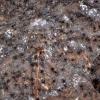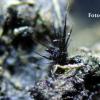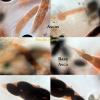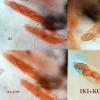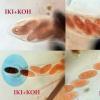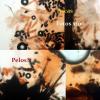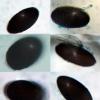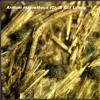
23-11-2025 11:16
Bohan JiaHi, I found small discs growing on dead stem of

21-11-2025 10:56
 Christopher Engelhardt
Christopher Engelhardt
Very small (~0,5 mm) white ascos, found yesterday

21-11-2025 11:52
Jean-Luc RangerBonjour à tous, on voit toujours 2 espèces areni

14-11-2025 16:26
 Marian Jagers
Marian Jagers
Hello everyone, On dead wood of Cytisus scoparius

17-11-2025 21:46
Philippe PELLICIERBonjour,Récolté sur bois pourrissant de feuillu
En excrementos de caballo
Castillo Joseba,
14-12-2014 13:35
Jacky Launoy,
14-12-2014 16:10
Re : En excrementos de caballo
Hola,
try Podospora australis. See in Doveri pagina 960 961
try Podospora australis. See in Doveri pagina 960 961
Peter Püwert,
14-12-2014 16:49
Re : En excrementos de caballo
Hi all,
in my opinion isn't a Podospora species. Maybe Arnium cf. macrothecum. P. australis have four spores only.
Greetings Peter.
in my opinion isn't a Podospora species. Maybe Arnium cf. macrothecum. P. australis have four spores only.
Greetings Peter.
Castillo Joseba,
14-12-2014 17:09
Re : En excrementos de caballo
Peter ... hay algun enlace o documento donde pueda ver Arnium macrothecum... tienes información de medidas esporales o detalles para la identificación ?
Michel Delpont,
14-12-2014 17:43

Re : En excrementos de caballo
Bonsoir.
Effectivement il ne s'agit pas de Podospora australis qui lui ne possède que quatre spores par asques, des spores également plus longues et des poils différents. Arnium macrotheca semble être une bonne direction, mais il faudrait vérifier sur des spores mûres, en dehors des asques qu'il n'y a pas d'appendices mais une enveloppe fimbriée autour de la spore. Ce caractère n'est pas toujours facile à observer et il vaut mieux colorer la préparation ( par ex. avec de l'encre ).
Michel.
Effectivement il ne s'agit pas de Podospora australis qui lui ne possède que quatre spores par asques, des spores également plus longues et des poils différents. Arnium macrotheca semble être une bonne direction, mais il faudrait vérifier sur des spores mûres, en dehors des asques qu'il n'y a pas d'appendices mais une enveloppe fimbriée autour de la spore. Ce caractère n'est pas toujours facile à observer et il vaut mieux colorer la préparation ( par ex. avec de l'encre ).
Michel.
Castillo Joseba,
14-12-2014 19:30
Michel Delpont,
14-12-2014 20:28

Re : En excrementos de caballo
Puede ser traducido por envoltura gelatinosa irregular. Visualización de los registros en la base de datos. Para el tinte sólo tratar con tinta ordinaria, a veces puede ser apropiado.
Michel.
Michel.
Norbert Heine,
14-12-2014 23:47

Re : En excrementos de caballo
Hola,
also in my opinion it is Arnium macrotheca (Cr. & Cr.) Lundq., like Peter said.
Typical are the stiff hairtufts on the necks (I found it until 500 µm long!) and the ascospores surrounded by a gelatinous sheath not blackening in Indian Ink.
Also your microscopic measurements fit very well with A. macrotheca.
I found it only few times in Germany, always on old horse dung.
Here are some pictures from my last gathering to compare.
Norbert
also in my opinion it is Arnium macrotheca (Cr. & Cr.) Lundq., like Peter said.
Typical are the stiff hairtufts on the necks (I found it until 500 µm long!) and the ascospores surrounded by a gelatinous sheath not blackening in Indian Ink.
Also your microscopic measurements fit very well with A. macrotheca.
I found it only few times in Germany, always on old horse dung.
Here are some pictures from my last gathering to compare.
Norbert


